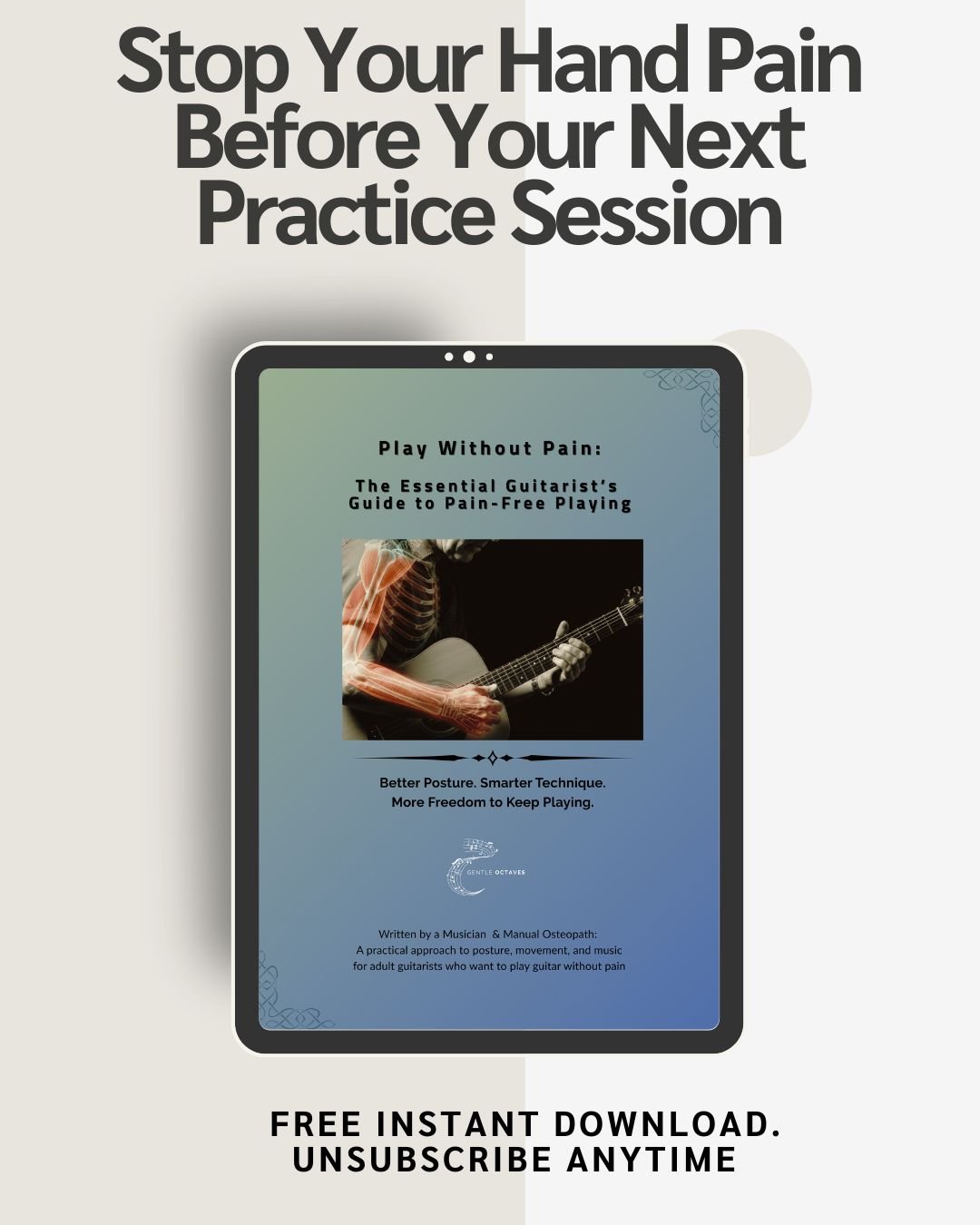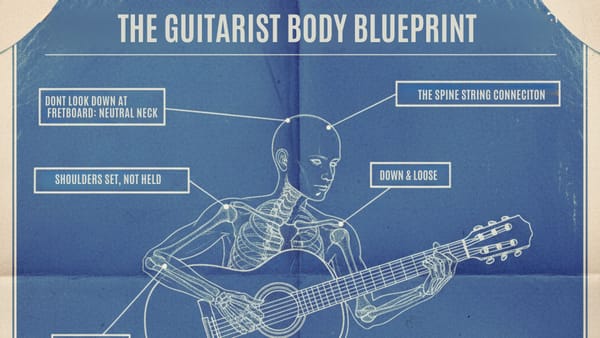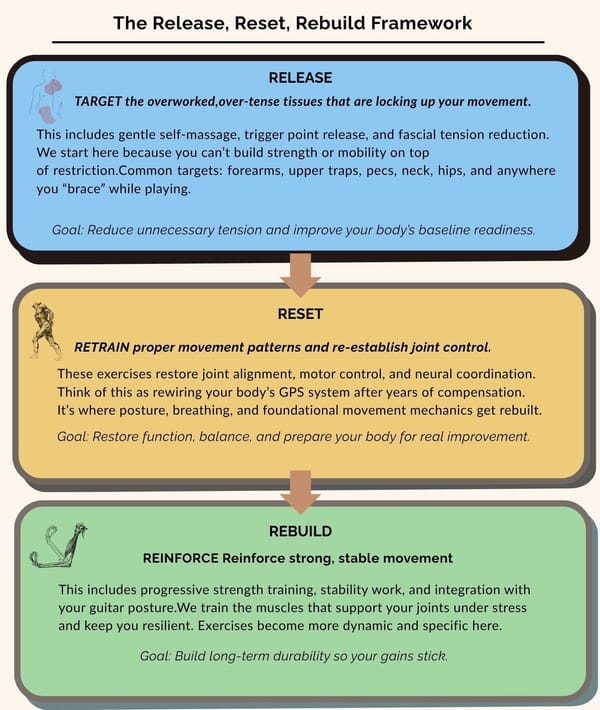Best Guitars for Arthritis That Keep You Playing Without Pain
You don't adapt your hands to fit the guitar. You find the guitar that fits your hands.

You don't adapt your hands to fit the guitar. You find the guitar that fits your hands.
If choosing the wrong guitar with arthritis feels like wearing shoes two sizes too small, you’re not wrong you can force it, but you’ll pay for it later.
I've worked with dozens of players over 40 dealing with arthritis, stiff joints, and hand pain. And here's what I've learned: the instrument matters as much as technique.
A heavy dreadnought with high action and thick strings? That's asking your hands to fight a battle they don't need to fight. But a lighter-bodied guitar with a slim neck, short scale, and low action? That's an instrument working with you, not against you.
This post will show you exactly what to look for in an arthritis-friendly guitar: neck profile, scale length, string tension, body weight and give you specific models worth trying so you can play longer and hurt less.
Why Guitar Choice Matters With Arthritis
Most players think hand pain is just about aging or weakness or bad technique. And yes, those things matter.
But if your guitar is set up wrong: if the action's too high, the strings too heavy, the neck too thick, then you're compensating with extra grip pressure and awkward hand angles before you even play a note.
I had a student, woman in her late fifties, who'd been struggling through songs on a heavy dreadnought for months. Her hands would ache after she played. She figured that's just how it was now.
We swapped her over to a Taylor GS Mini: smaller body, shorter scale, lighter weight. She noticed she could double her playing time.
Same hands. Different guitar. Completely different experience.
So yeah, the instrument matters. You can have perfect technique on the wrong guitar and still end up in pain.
Or you can have decent technique on the right guitar and play comfortably for years.
For some more on technique specific to arthritis limitations read my post on Arthritis-Friendly Guitar Chords That Sound Great Without Hurting Your Hands
What to Look For (The Actual Specs That Matter)
1. Neck Profile
This is the shape of the neck where your hand grips. Some necks are thick and rounded like a baseball bat. Others are slim and flat like a modern C-shape.
For most arthritic hands, slim "C" profiles are easier to wrap around. Less reach. Less grip. Less strain on the thumb.
Avoid thick vintage-style necks unless you've got large hands and zero thumb issues. Otherwise you're just making your hand work harder than it needs to.
2. Scale Length
Scale length is the distance from the nut to the bridge (basically, how far apart the frets are).
Shorter scale = less stretch between frets.
Standard Fender scale is 25.5 inches. Gibson-style is 24.75 inches. For arthritis-friendly playing, aim for something in the 24–24.75 inch range. You'll notice the difference immediately when you're reaching for that pinky stretch or barring across multiple frets.
If you can play a C chord without your pinky feeling like it's auditioning for a gymnastics team, you're probably in your scale length sweet spot.
By the way you can and should also adapt the type of chords you play if arthritis is a problem for you of if you have any other restrictions in your playing finger/hand mobility.
Check out these friendly version of common chords that can also make a big difference.
3. String Action & Tension
Action is the height of the strings above the frets. High action means you press harder. Low action means less effort, cleaner sound, happier hands.
It always amazes me how many guitarists with hand pain haven't considered lowering their action or don't understand how much it can help. This is one of those unglamorous fixes that makes a massive difference.
Take your guitar to a tech. Pay the $50-80 to have it properly set up. They'll lower the action, check the intonation, maybe file down any sharp fret edges. Your hands will thank you.
While you're at it, switch to lighter gauge strings:
- Electric: .010 or .011 gauge
- Acoustic: .011 or .012 gauge
Every major string manufacturer makes light gauge options. For the average player dealing with hand pain, this is a no-brainer change. Less tension means less force required to fret.
4. Body Size & Weight
If the guitar feels heavy after fifteen minutes, you'll start compensating with your posture. Your shoulder hunches. Your back rounds. Your wrist bends at sharper angles. And that's when pain creeps in.
Look for lighter, smaller-bodied guitars. You don't need a massive dreadnought to get good sound. Modern parlor and grand concert body shapes can sound just as full without the weight.
If it feels like you're holding a log, your posture's going to file a complaint.
Again a simple fix that can make a big difference.
Specific Guitars Worth Trying
I'm not getting paid to recommend these. These are just instruments I've seen work well for players dealing with arthritis and hand pain.
Acoustic Options
Taylor GS Mini – Smaller body, shorter scale (23.5"), surprisingly full sound. Great for fingerpicking or light strumming. Comfortable for hours.
Yamaha APX Series – Slim body, cutaway design, easy access to upper frets. Built for comfort and playability.
Martin LX1 Little Martin – Compact, lightweight, decent tone for its size. Good travel guitar that's also gentle on aging hands.
Electric Options
Fender Mustang – Short scale (24"), lightweight, versatile. Classic rock tones without the strain.
PRS SE Models – Comfortable neck profiles, medium weight, excellent playability. Good bang for your buck.
Gibson SG – Lightweight (no heavy maple top), short scale (24.75"), slim neck. Classic sound, easy on the body.
These aren't the only options, but they're solid starting points. Go play them. See what feels right in your hands. Trust what your body's telling you.
The Nylon String Option (Don't Dismiss It)
Yeah, I know. Nylon strings sound like "beginner guitars" or "classical music only." But hear me out.
Modern crossover nylon guitars are versatile, comfortable, and legitimately easier on arthritic hands. They're not just for kids learning "Twinkle Twinkle."
Why nylon can help:
Lower tension. Nylon strings require way less pressure to fret than steel. That's huge if your hands fatigue quickly or you're dealing with joint inflammation.
Softer on fingers. No cheese-wire feeling. No callus-building agony. Just gentle contact that doesn't punish your fingertips.
Lighter builds. Many nylon-string guitars are physically lighter than steel-string acoustics, so your shoulder and neck don't fatigue as quickly either.
The trade-off? Tone. Nylon has that warmer, mellower voice beautiful for fingerstyle, classical, bossa nova, softer folk. But it won't give you the bright "zing" of steel strings if you're after punchy strumming or rock tones.
Worth trying:
Yamaha NTX Series – Slim body, nylon crossover. Feels closer to a steel-string acoustic in shape and playability.
Cordoba Fusion Series – Designed for steel-string players transitioning to nylon. Slightly narrower necks, lighter builds.
Taylor Academy 12-N – Lighter, slimmed-down design with nylon strings. Very player-friendly. Taylor quality without the heavy price tag.
I've had clients who swore they'd never play nylon strings. Then they tried a Yamaha NTX for ten minutes and completely changed their mind. Don't let assumptions keep you from something that might work.
Try This: The Comfort Test
Next time you're in a music store or trying out a guitar, do this simple check:
- Hold the guitar for 5 minutes without playing. Just hold it. How does your shoulder feel? Your back? Is the weight manageable?
- Play a simple chord progression (G-C-D or whatever you know well). Notice:
- How far are you reaching between frets?
- Is your thumb cramping on the back of the neck?
- Can you hold a barre chord without white-knuckling it?
- Strum or fingerpick for another 5 minutes. Pay attention to fatigue. If you're already uncomfortable after ten minutes in the store, it's going to be worse at home.
The right guitar should feel like it's helping you, not fighting you. If it doesn't pass this basic comfort test, keep looking.
Got the right instrument and still struggle with pain? Read my post on 5 Ways to Reduce Guitar Hand Pain and Keep Playing for Years
Final Note
It’s not about the fanciest guitar it’s about the one you can play comfortably for years.
The easier the guitar feels to play, the harder it will be to put down.
Your Invitation
If you've found a guitar that works beautifully with your arthritis or hand pain, I'd love to hear about it. What model? What made the difference?
Reply and let me know your recommendation might help another player keep going.
And if you're still struggling to find setup that works, I've put together a guide with practical tips for making any guitar more comfortable:
Check out more in Guitar Setup Secrets:
Inside, you'll find:
- Step-by-step action and string adjustments
- Posture resets that reduce strain
- Warm-up routines for stiff hands
- Troubleshooting for common pain points
No fluff. Just practical help.
F.P

F.P. O’Connor
F.P. O’Connor is a manual osteopath, psychology grad, and lifelong musician who helps adults play with less pain and more confidence.
Through Gentle Octaves Studio, he blends science, movement, and musicianship to help mature players keep creating for life.
Release → Reset → Rebuild™ your sound
F.A.Q.
Q: What features should I look for in a guitar if I have arthritis or joint pain in my hands?
A: Focus on lighter gauge strings, shorter scale lengths (24–24.75"), lower string action, and slim neck profiles. These specs reduce the force and reach your hands need, making playing significantly more comfortable.
Q: Can changing my guitar setup really make a difference in pain and playability?
A: Absolutely. Lowering action, switching to lighter strings, and adjusting neck relief can transform how a guitar feels often without any tonal sacrifice. A $50-80 professional setup can make your current guitar feel like a different instrument.
Q: Should I buy a custom guitar designed for arthritic hands or modify a standard one?
A: Both work. Custom builds offer optimized comfort but cost more. Modifying a quality standard guitar with proper setup, lighter strings, and possibly a shorter scale model delivers major benefits and is usually more cost-effective.
Q: Are nylon-string guitars really a good option for adults with hand pain?
A: Yes modern crossover nylon guitars aren't just for beginners. They require less finger pressure, are gentler on joints, and many have slimmer necks than traditional classical guitars. The trade-off is tone: warmer and mellower rather than bright and zingy.
Q: At what point should I stop playing or seek medical advice for hand pain?
A: If you experience sharp pain, numbness, persistent swelling, or pain that lasts well beyond your playing session, pause and consult a hand specialist. Dull aches can usually be managed with setup and technique adjustments. Sharp or radiating pain needs professional attention.
Sources & Science
- Fender. (2022). Scale length specifications and playability.
https://fender.com - Gibson. (2022). Gibson scale length and ergonomic design.
https://gibson.com - PRS Guitars. (2023). SE series specifications and neck profiles.
https://prsguitars.com






